What is Metallic Glass?
Metallic Glass (Bulk Metallic Glass / liquid metal) is a new type of amorphous metal with unique features.
Conventional amorphous metal could only be used to make thin and small items because it crystallizes unless
rapidly cooled from the molten alloy state.
Metallic Glass, however, solidifies without crystallization even if cooled down slowly from the molten alloy
state, so relatively large bulk products can be fabricated, expanding the range of applications for
industrial use.
In addition, Metallic Glass has several excellent mechanical properties, such as high strength, low Young's
modulus, high transferability, and excellent corrosion resistance.
Utilizing these characteristics makes application possible in a variety of fields, such as high-precision
components, exterior components, sensors, springs, sports equipment, and biomaterials.
Difference in atomic arrangement between normal metal and metallic glass
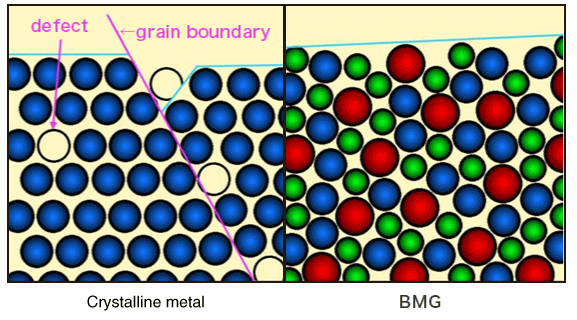
Superior features of Metallic Glass: high-precision transfer
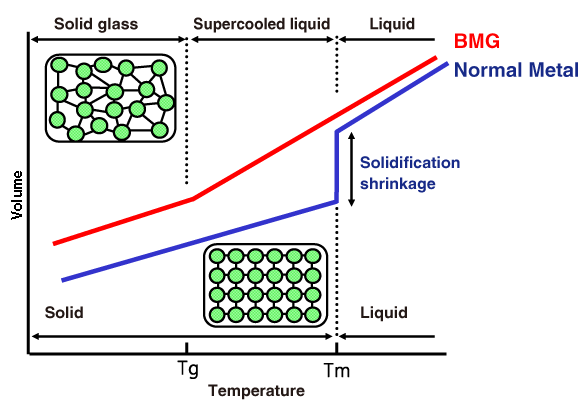
When cooling from liquid state, no solidification shrinkage occurs, and it solidifies into a non-crystalline state.
Good dimensional accuracy & high molding transfer precision
The above chart shows the relationship between the temperature and volume of metallic glass. (Red line:
metallic glass, Blue line: normal metal).
When cooling from liquid state, normal metal undergoes solidification shrinkage associated with
crystallization, which results in a reduced volume.
Metallic glass, however, solidifies in non-crystalline state. Therefore, the surface of the mold can be
fully transferred, and parts can be manufactured with high dimensional accuracy.
Metallic glass's molding transfer precision
Photos of the mold's surface and the casting surface.
The processed pattern on the mold's surface is fully transferred onto the casting's surface.
Surface transfer of an EDM-produced mold

Surface transfer of a polished mold

Surface transfer of a character mold
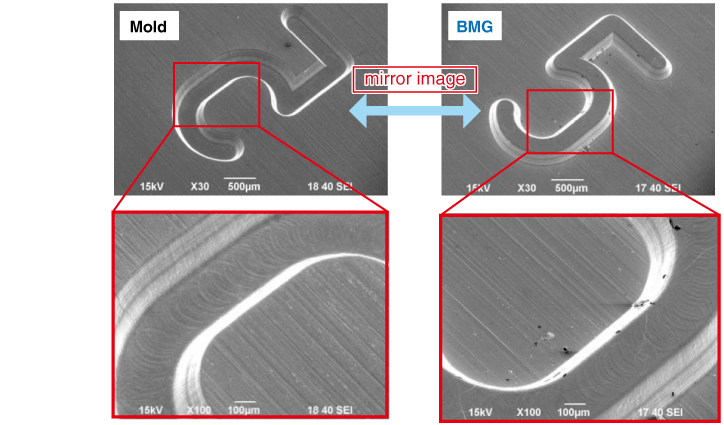
Metallic glass's corrosion resistance
Normal metal has grain boundaries as shown in the above figure, which can be starting points for corrosion. Metallic glass, however, doesn't have grain boundaries, and a continuous passive film forms on the surface. Therefore, it doesn't corrode easily, even in harsh environments.
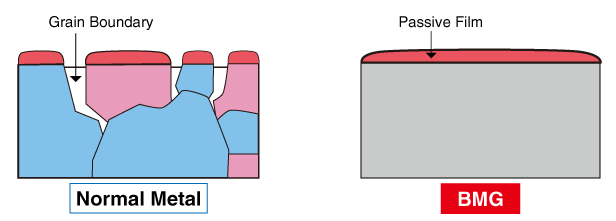
Metallic glass's physical properties
| Item (unit) | Zr-BMG physical properties
Composition(wt%): Zr67.02Cu25.46Ni3.92Al3.60 (at%): Zr55Cu30Al10Ni5 |
|---|---|
| Density [g/cm3] | 6.8 |
| Tensile strength [MPa] | 1620 |
| Vickers hardness [Hv] | 520 |
| Young's modulus [GPa] | 81 |
| Poisson's ratio | 0.34 |
| Resistivity [μΩ・cm 80℃] | 180 - 210 |
| Magnetic susceptibility [μemu / (g・Oe) 20℃] | 1.2 - 1.5 |
| Melting point [℃] | 890 |
| Glass-transition temp. [℃] | 410 |
| Thermal expansion coefficient (E-6/℃) | 10.9 |
| Thermal conductivity [W/(m・K)] | 5.5 |
| Specific heat [kJ/(kg・K)] | 0.33 |
Metallic glass micro gear

Moldable by near net shape
Metallic glass process flow
Metallic glass is produced by injection molding, in which the alloy is melted and injected into a mold.
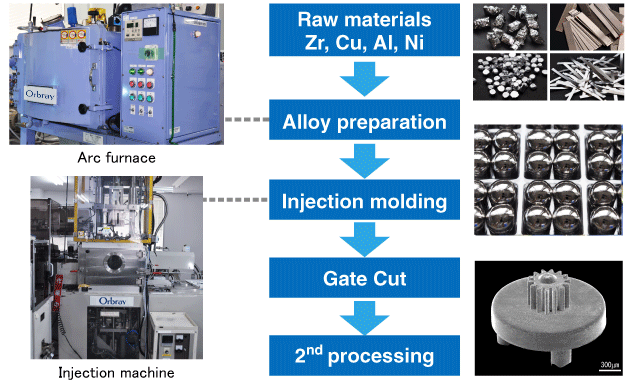
Surface treatment of metallic glass
When oxidized, metallic glass turns a dark blue color and a hard film forms on the surface, making it even
more scratch-resistant.
The color of the metallic glass can also be changed by applying IP coating, DLC coating, etc.
In addition, IP coating, DLC coating, etc., can be applied to change the color of the metallic glass.
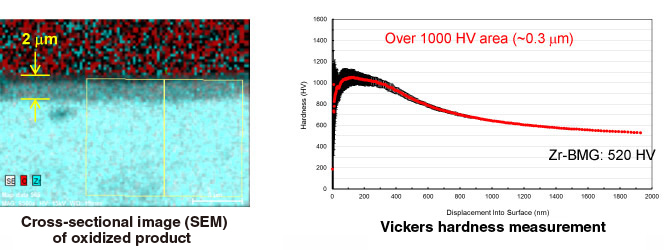
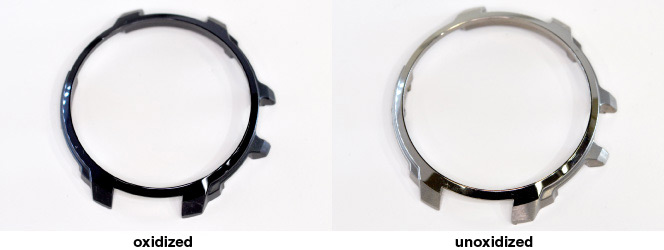
Metallic glass's superior features
Metallic glass is expected to be applicable in a variety of fields due to its superior features such as high strength, precision mold transferability, corrosion resistance, and flexibility.
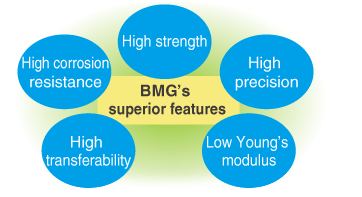
Micro gear
Metallic glass is expected to be applicable in a variety of fields due to its superior features such as high strength, precision mold transferability, corrosion resistance, and flexibility.
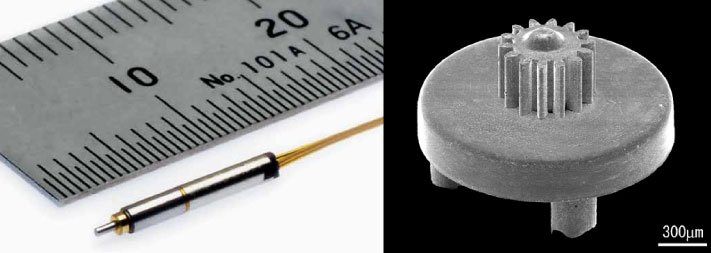
Expected Applications
Watch exterior, glasses and accessories
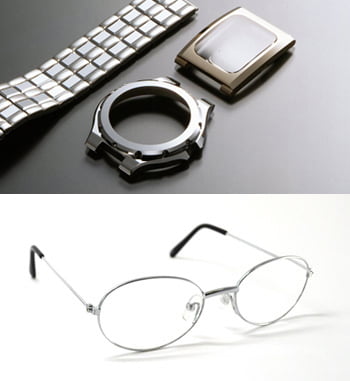
Metallic glass can be used to create products that are high-strength and
scratch-resistant. It does not corrode even in harsh environments and does not cause metal allergies or
associated skin reactions.
Our company's metallic glass has been used and commercialized for the exterior parts of luxury watches.
Glasses parts and accessories
With characteristics including flexibility and high strength, metallic glass is expected to be useful
in making eyeglass parts. Unique designs can be achieved by forming fine patterns and logos on the
surface.
These features also make metallic glass a promising material for rings and other accessories.
Automobile pressure sensor
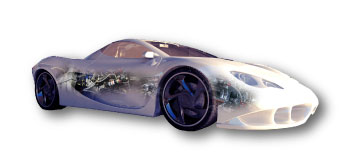
In recent years, with the advancement of process control in the automotive and other industries, there is a need for advanced sensors. Metallic glass has the advantage of being about three times more flexible than normal metals. By using Metallic glass for the diaphragm of a pressure sensor, the diaphragm is more flexible, resulting in a high strength, high sensitivity sensor.
Semiconductor collet
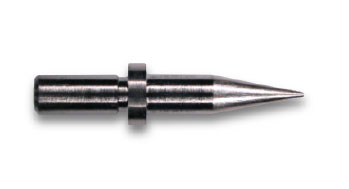
With the miniaturization of semiconductor chip parts and the acceleration of assembly, there is a corresponding demand for semiconductor die collets with higher strength and fine nozzles. By combining our metallic glass forming technology and fine hole processing technology, we can produce a collet for chip transfer that has a fine nozzle and excellent abrasion resistance. In addition, using metallic glass can solve material-based issues, such as malfunctions caused by static electricity with resin collets, or chipping problems with ceramic collets. Additionally, there are other expected applications for this technology in the semiconductor manufacturing field, such as fine nozzles used to apply adhesive.
Orthodontic tool, biomaterial, artificial joint
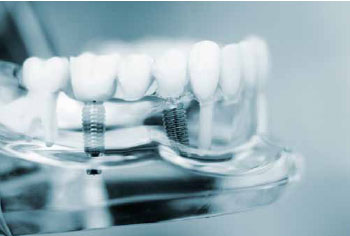
Small, high-precision orthodontic brackets can be manufactured using metallic glass. We
have developed a small, circular orthodontic bracket of our own design. High precision slot formation
minimizes movement of the corrective wire and facilitates treatment.
Additionally, the reduction in size can ease the burden on the patient during correction as well as
discomfort in the mouth.
BMG is also under consideration for use in biomaterial applications such as artificial bones and dental
implants. Currently titanium, which has excellent biocompatibility, is the main material used for these,
but there are problems such as poor processability and limited shape. BMG has high strength, flexibility,
and a high degree of freedom in shape, and is expected to be a next-generation material to replace
titanium.
Acoustic parts
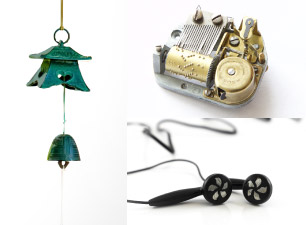
Metallic glass is characterized by a low vibration damping rate. For example, wind chimes made of
metallic glass have a long-lasting beautiful tone.
Taking advantage of this feature, it is expected
to be applied to musical instruments and audio equipment.
For research and development
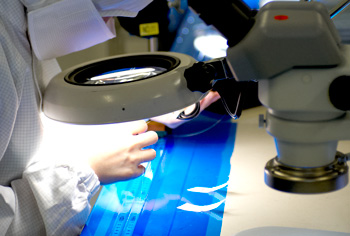
We offer metallic glass as an evaluation material for research and development departments
of universities, research institutes, and companies conducting basic research on new materials.
We will propose the most suitable size and shape based on the purpose of the evaluation, including for
small quantities.


